
The Battle of Solferino on 24 June 1859 resulted in the victory of the allied French Army under Napoleon III and the Piedmont-Sardinian Army under Victor Emmanuel II against the Austrian Army under Emperor Franz Joseph I. It was the last major battle in world history where all the armies were under the personal command of their monarchs. Perhaps 300,000 soldiers fought in the important battle, the largest since the Battle of Leipzig in 1813. There were about 130,000 Austrian troops and a combined total of 140,000 French and allied Piedmontese troops. After the battle, the Austrian Emperor refrained from further direct command of the army.

Baron Géza Fejérváry de Komlóskeresztes was a Hungarian general who served as the prime minister in a government of bureaucrats appointed by King Franz Joseph during the Hungarian Constitutional Crisis of 1903–1907.

Ludwig August Ritter von Benedek, also known as Lajos Benedek, with the Hungarian form of Ludwig, was an Austro-Hungarian general (Feldzeugmeister), best known for commanding the imperial army in 1866 in their defeat at the Battle of Königgrätz against the Prussian Army, which ended his career.

The Order of the Black Eagle was the highest order of chivalry in the Kingdom of Prussia. The order was founded on 17 January 1701 by Elector Friedrich III of Brandenburg. In his Dutch exile after World War I, deposed Emperor Wilhelm II continued to award the order to his family. He made his second wife, Princess Hermine Reuss of Greiz, a Lady in the Order of the Black Eagle.

The Order of the Redeemer, also known as the Order of the Saviour, is an order of merit of Greece. The Order of the Redeemer is the oldest and highest decoration awarded by the modern Greek state.

The House of Liechtenstein, from which the principality takes its name, is the family which reigns by hereditary right over the principality of Liechtenstein. Only dynastic members of the family are eligible to inherit the throne. The dynasty's membership, rights and responsibilities are defined by a law of the family, which is enforced by the reigning prince and may be altered by vote among the family's dynasts, but which may not be altered by the Government or Parliament of Liechtenstein.

The Military Order of Maria Theresa was the highest military honour of the Habsburg monarchy, Austrian Empire and Austro-Hungarian Empire.
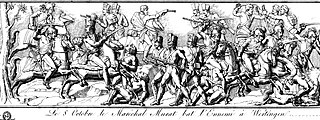
In the Battle of Wertingen Imperial French forces led by Marshals Joachim Murat and Jean Lannes attacked a small Austrian corps commanded by Feldmarschall-Leutnant Franz Xaver von Auffenberg. This action, the first battle of the Ulm Campaign, resulted in a clear French victory. Wertingen lies 28 kilometres (17 mi) northwest of Augsburg. The combat was fought during the War of the Third Coalition, part of the Napoleonic Wars.
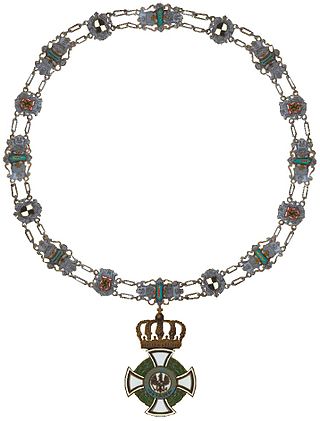
The House Order of Hohenzollern was a dynastic order of knighthood of the House of Hohenzollern awarded to military commissioned officers and civilians of comparable status. Associated with the various versions of the order were crosses and medals which could be awarded to lower-ranking soldiers and civilians.
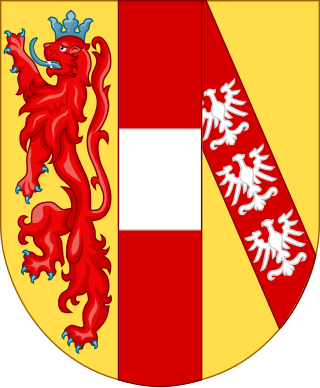
The House of Habsburg-Lorraine originated from the marriage in 1736 of Francis III, Duke of Lorraine and Bar, and Maria Theresa of Austria, later successively Queen of Bohemia, Queen of Hungary, Queen of Croatia and Archduchess of Austria. Its members are the legitimate surviving line of both the House of Habsburg and the House of Lorraine and inherit their patrimonial possessions and vocation to the Empire from their female line of the House of Habsburg and from the male line of the House of Lorraine.

The Order of Saint Stephen was an order of chivalry founded in 1764 by Maria Theresa. In 1938, Miklós Horthy took the rights and activities of Grand Master as Regent of Hungary. The name of the Order changed to the Royal Hungarian Order of Saint Stephen. The Order was terminated at the time of the proclamation of the Second Hungarian Republic in 1946. It was recreated in 2011 as the Hungarian Order of Saint Stephen, and to this day remains the highest order in Hungary.

The House and Merit Order of Duke Peter Frederick Louis or proper German Oldenburg House and Merit Order of Duke Peter Frederick Louis was a civil and military order of the Grand Duchy of Oldenburg, a member state of the German Empire. The order was founded by Grand Duke Augustus of Oldenburg on 27 November 1838, to honor his father, Peter Frederick Louis of Oldenburg. It became obsolete in 1918 after the abdication of the last grand duke.
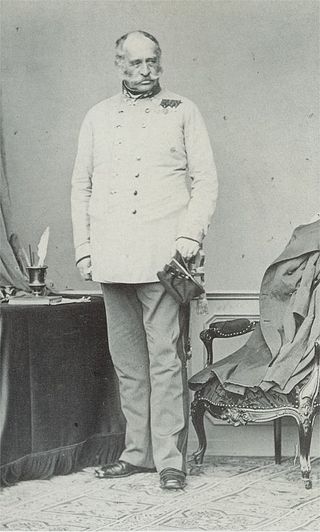
Franz Emil Lorenz Heeremann Graf von Wimpffen was an Austrian General and Admiral who served as Administrative Head of the Austro-Hungarian Navy from 1851 to 1854.

The Order of the Cross of Takovo was a Serbian state order.
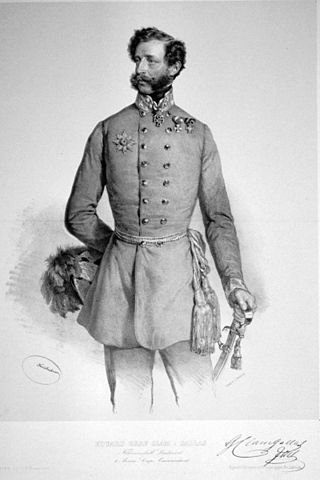
Count Eduard Clam-Gallas was an Austrian general. He was the eldest son of Count Christian Christoph Clam-Gallas (1771–1838), patron of Beethoven, and Countess Josephine Clary-Aldringen (1777–1828).

The Battle of Verona was fought on 18 October 1805 between the French Army of Italy under the command of André Masséna and an Austrian army led by Archduke Charles, Duke of Teschen. By the end of the day, Massena seized a bridgehead on the east bank of the Adige River, driving back the defending troops under Josef Philipp Vukassovich. The action took place near the city of Verona in northern Italy during the War of the Third Coalition, part of the Napoleonic Wars.

Louis Charles Folliot de Crenneville joined the French royal navy in the 1770s. During the French Revolution he abandoned the First French Republic and became an Émigré. Soon afterward, he tendered his services to Habsburg Austria. He earned promotion to general officer during the Napoleonic Wars and fought in all the major campaigns against his former country. He led a division during the War of the Sixth Coalition and remained in Austrian service until his death.

The House Order of Albert the Bear was founded in 1836 as a joint House Order by three dukes of Anhalt from separate branches of the family: Henry, Duke of Anhalt-Köthen, Leopold IV, Duke of Anhalt-Dessau, and Alexander Karl, Duke of Anhalt-Bernburg.
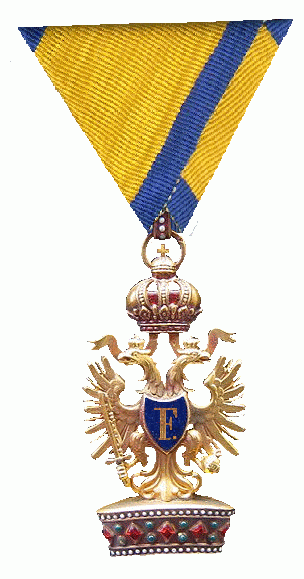
The Imperial Order of the Iron Crown was one of the highest orders of merit in the Austrian Empire and Austria-Hungary until 1918. It was founded in 1815 by Emperor Franz I of Austria as a re-establishment of the original Order of the Iron Crown, which previously had been an order of the Napoleonic Kingdom of Italy.

Count Franz Folliot de Crenneville, was an Austrian feldzeugmeister and Oberstkämmerer of Emperor Franz Joseph.




















